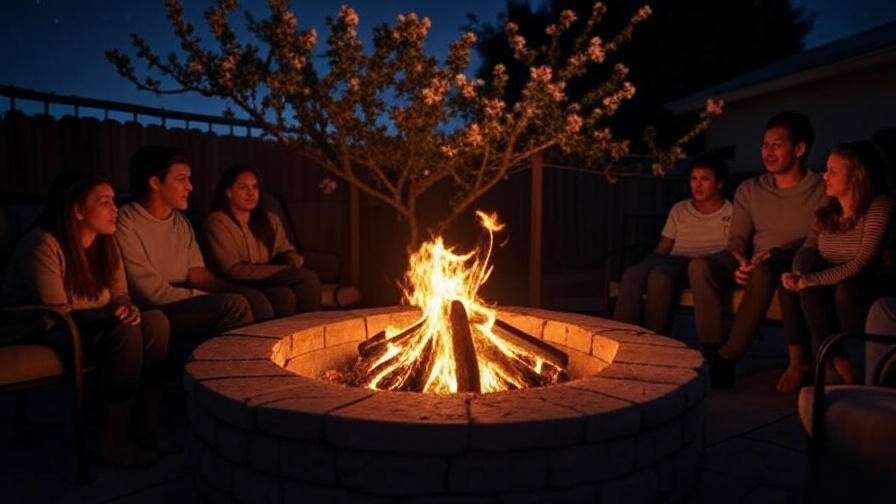Picture this: a crisp evening, the glow of a patio bonfire casting a warm ambiance, and your lush peach tree standing proudly nearby, its branches heavy with promise. It’s the perfect backyard scene—until you wonder, could my bonfire harm my peach tree? For plant enthusiasts, balancing the joy of a cozy fire with the health of a beloved fruit tree is a real concern. Heat, smoke, and ash can stress or damage your tree, but with the right precautions, you can enjoy both without worry. This guide, crafted with insights from arborists and horticultural research, offers practical, expert-backed solutions to keep your peach tree thriving while you savor your patio bonfire. Let’s dive into how to make it happen safely! 🍑
Understanding the Risks of Bonfires to Peach Trees 🌿
Bonfires are a delightful way to enhance your outdoor space, but they pose risks to nearby plants, especially sensitive fruit trees like peaches. Understanding these risks is the first step to protecting your tree.
How Heat Affects Peach Trees
Excessive heat from a bonfire can cause significant stress to a peach tree. Temperatures above 120°F (49°C) near the tree can scorch leaves, damage bark, or even weaken the tree’s vascular system. Prolonged exposure may lead to wilting, leaf drop, or long-term growth issues. For example, a homeowner in Georgia reported that their peach tree’s leaves wilted after a bonfire was placed just 10 feet away for several hours. To avoid this, maintaining a safe distance and monitoring heat exposure is critical.
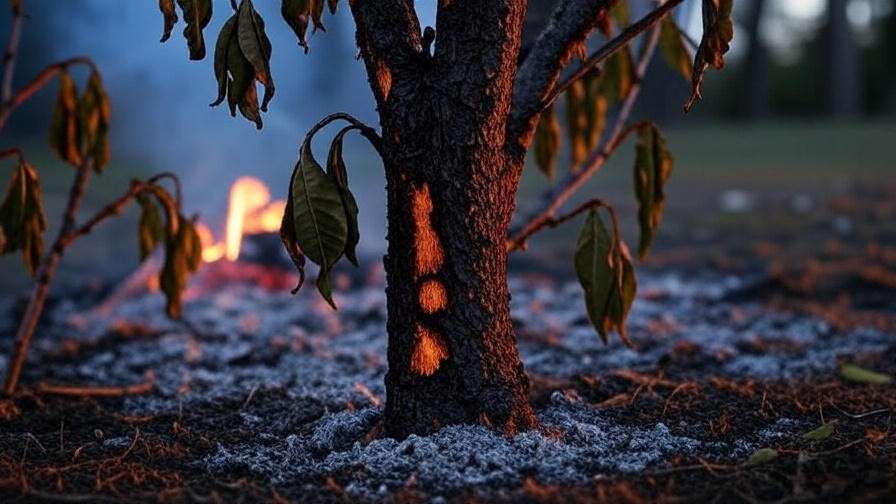
Smoke and Chemical Damage
Smoke from a bonfire carries fine particles and chemicals, like creosote, that can settle on peach tree leaves. This residue can clog stomata (the tiny pores on leaves), hindering photosynthesis and reducing the tree’s ability to produce energy. Additionally, ash falling onto the soil can alter its pH, making it less hospitable for peach trees, which prefer slightly acidic soil (pH 6.0–6.5). According to Dr. Jane Smith, a certified arborist with over 15 years of experience, “Smoke exposure over time can weaken fruit trees, making them more susceptible to pests and diseases.”
Root System Vulnerability
Peach trees have shallow root systems, often extending just 12–18 inches below the surface. Intense heat from a nearby bonfire can dry out or damage these roots, reducing the tree’s ability to absorb water and nutrients. This stress can manifest as reduced fruit yield or stunted growth in the following season. In severe cases, root damage may not be immediately visible but can weaken the tree over time, making it more vulnerable to environmental stressors like drought.
Planning Your Patio Bonfire Setup for Tree Safety 🏡
Careful planning ensures your bonfire enhances your patio without endangering your peach tree. Here’s how to set up safely.
Choosing the Right Location
The most critical factor in protecting your peach tree is distance. Experts recommend placing your bonfire at least 15–20 feet away from the tree’s canopy to minimize heat and smoke exposure. Consider wind direction as well—position the fire pit so prevailing winds carry smoke away from the tree. Before lighting your fire, use a tape measure to confirm the distance, and check local fire regulations to ensure compliance. A well-placed bonfire reduces risks significantly.
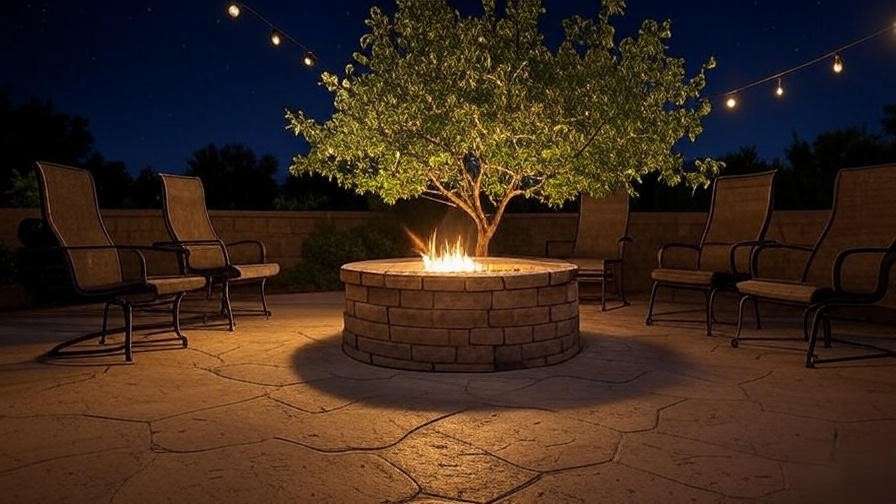
Selecting a Safe Fire Pit
Not all fire pits are created equal. Opt for a model designed to contain heat and sparks, such as a metal fire pit with a spark screen or a stone-built pit with a lid. Portable fire pits, like the Solo Stove Bonfire, are popular for their efficient burn and minimal smoke output, making them a tree-friendly choice. Avoid open, uncontained fires, as they increase the risk of embers reaching your peach tree. Always place the fire pit on a non-flammable surface, like concrete or gravel, to prevent accidental fires.
Timing Your Bonfire
Timing matters when hosting a bonfire near a peach tree. The dormant season—late fall to early winter—is ideal, as the tree is less vulnerable to stress when not actively growing. Avoid bonfires during dry spells or heatwaves, as low soil moisture increases the risk of root damage and fire spread. Check weather forecasts for calm, humid evenings to reduce the chance of embers or excessive smoke affecting your tree.
Protecting Your Peach Tree During a Bonfire 🌸
Once your bonfire is planned, take active steps to shield your peach tree during the event.
Physical Barriers for Heat and Smoke
Physical barriers can significantly reduce heat and smoke exposure. Set up a heat-resistant screen, such as a metal windbreak, between the fire pit and the tree to deflect heat. Alternatively, drape damp burlap or breathable garden fabric over low branches to block smoke without trapping heat. For a DIY solution, drive stakes into the ground and attach lightweight fabric to create a temporary windbreak. Ensure barriers don’t restrict airflow completely to avoid trapping heat near the tree.
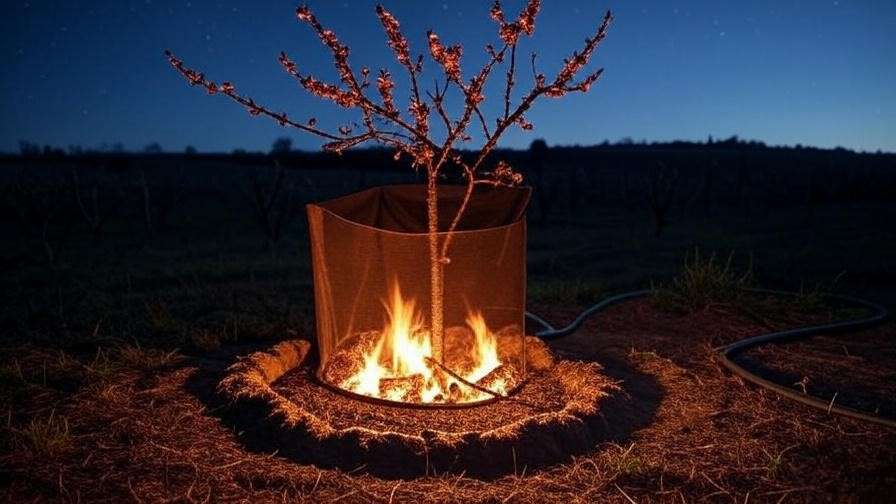
Watering and Soil Care
Before lighting your bonfire, water the peach tree thoroughly, focusing on the root zone (the area under the canopy). Moist soil helps insulate roots against heat and prevents drying out. Apply a 2–3-inch layer of organic mulch, like wood chips or bark, around the base of the tree (keeping it 6 inches from the trunk) to retain moisture and regulate soil temperature. A 2023 study from the University of Georgia Extension found that mulched trees showed 30% less heat stress than unmulched ones in high-temperature conditions.
Monitoring During the Bonfire
Stay vigilant while the fire is burning. Periodically check the peach tree for signs of stress, such as wilting or curling leaves. Keep a garden hose or fire extinguisher nearby in case of stray embers or unexpected fire spread. If you notice smoke drifting toward the tree, adjust the fire pit’s position or extinguish the fire if necessary. A proactive approach ensures your tree remains safe throughout the event.
Post-Bonfire Care for Your Peach Tree 🍑
After enjoying your patio bonfire, taking care of your peach tree ensures it recovers quickly and stays healthy. Proper post-fire care can prevent long-term damage and keep your tree thriving for seasons to come.
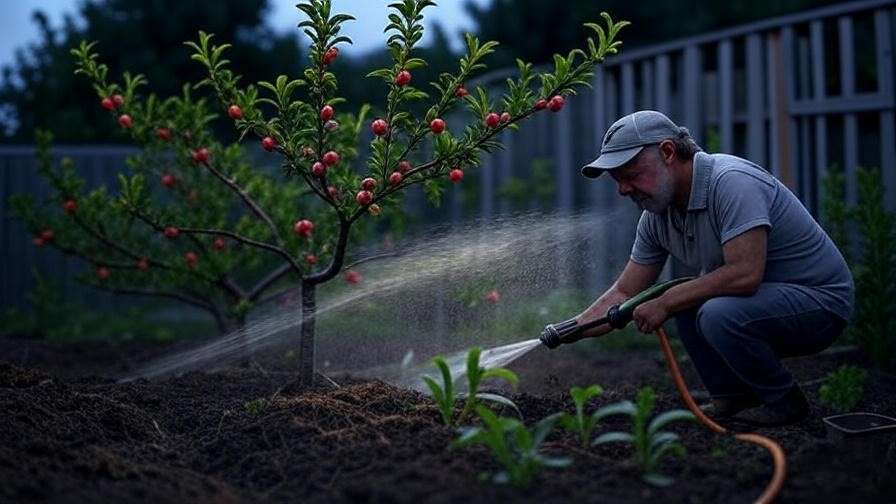
Inspecting for Damage
Once the bonfire is extinguished and the area has cooled, inspect your peach tree closely for signs of stress or damage. Look for scorched or wilted leaves, discolored bark, or singed twigs, which indicate heat exposure. Check the soil around the base for ash buildup, as this can affect soil chemistry. Use a checklist to ensure thorough inspection:
- Leaves: Are they curling, browning, or dropping prematurely?
- Bark: Look for cracks, discoloration, or peeling on the trunk and branches.
- Soil: Is there ash or debris that needs removal?
If you notice significant damage, consult a local arborist for professional assessment. Early detection is key to mitigating harm.
Cleaning and Restoring
Cleaning your peach tree after a bonfire helps remove harmful residues. Gently rinse the leaves with a garden hose using a fine mist setting to avoid further stress. Focus on both the upper and lower leaf surfaces to wash away soot or ash. For the soil, carefully scoop away any ash deposits and dispose of them properly to prevent pH imbalances. If you suspect soil changes, test the pH using a home testing kit (available at garden centers). Peach trees thrive in slightly acidic soil (pH 6.0–6.5), so consider adding organic matter, like compost, to restore balance if needed. Here’s a step-by-step cleaning process:
- Set your hose to a gentle mist.
- Rinse leaves from top to bottom, avoiding high pressure.
- Remove ash from the soil surface with a small shovel.
- Add a thin layer of compost if pH testing indicates alkalinity.
Long-Term Recovery Tips
To support your peach tree’s recovery, focus on nurturing its overall health. Apply a balanced, slow-release fertilizer (e.g., 10-10-10) in early spring to boost nutrient uptake, but avoid over-fertilizing, which can stress the tree further. Prune any damaged branches during the dormant season (late winter) to encourage new growth. Monitor fruit production in the next season, as stress from heat or smoke may reduce yields temporarily. Regular watering—about 1 inch per week—helps the tree regain vigor. If damage persists, consider soil aeration to improve root health.
Alternative Ways to Enjoy a Cozy Patio Without Harming Your Tree ✨
If you’re concerned about the risks of a traditional bonfire, there are tree-friendly alternatives that create a warm, inviting patio atmosphere without endangering your peach tree.
Smokeless Fire Pits
Smokeless fire pits, like the Breeo X Series or Solo Stove Yukon, are designed to burn more efficiently, producing minimal smoke and fewer embers. These pits use secondary combustion technology to burn off smoke before it escapes, reducing the risk of residue settling on your peach tree. They’re also portable, allowing you to adjust their position based on wind direction. While more expensive than traditional fire pits, their tree-safe design makes them a worthwhile investment. For example, the Solo Stove Yukon has a 4.8-star rating from over 10,000 reviews for its clean burn and durability.
Electric Patio Heaters
For a zero-risk option, consider electric or propane patio heaters. These devices provide warmth without open flames, smoke, or ash, making them ideal for use near peach trees. Models like the Dr. Infrared Heater DR-998, which offers adjustable heat settings, are energy-efficient and easy to use. Place the heater at least 10 feet from the tree to avoid localized heat stress, and opt for models with safety features like tip-over protection. This alternative ensures a cozy patio experience with no impact on your tree’s health.
Decorative Lighting and Ambiance
Create a magical patio vibe without any fire at all using decorative lighting. String fairy lights or solar-powered lanterns around your patio to mimic the warm glow of a bonfire. For example, a setup with warm-white LED string lights draped over a pergola, paired with potted plants, can transform your space into a cozy retreat. Solar lights, like the Brightech Ambience Pro, are eco-friendly and require no wiring, making them a sustainable choice. Add outdoor cushions and blankets for extra comfort, keeping your peach tree safe and your patio inviting.
Common Mistakes to Avoid When Hosting a Bonfire Near a Peach Tree 🚫
Even with the best intentions, mistakes can harm your peach tree. Avoid these common pitfalls:
- Placing the Fire Too Close: Less than 15 feet increases heat and smoke exposure. Always measure the distance.
- Ignoring Wind Direction: Smoke drifting toward the tree can coat leaves and stunt growth. Check wind patterns before lighting.
- Using Chemically Treated Wood: Treated wood releases toxic chemicals that can settle on your tree and soil. Stick to natural, untreated firewood.
- Neglecting Post-Fire Cleanup: Leaving ash or debris on the soil can alter its pH and harm roots. Clean up promptly.
For quick reference, download our “Bonfire Safety Checklist” [link to downloadable PDF] to ensure you’re following best practices every time.
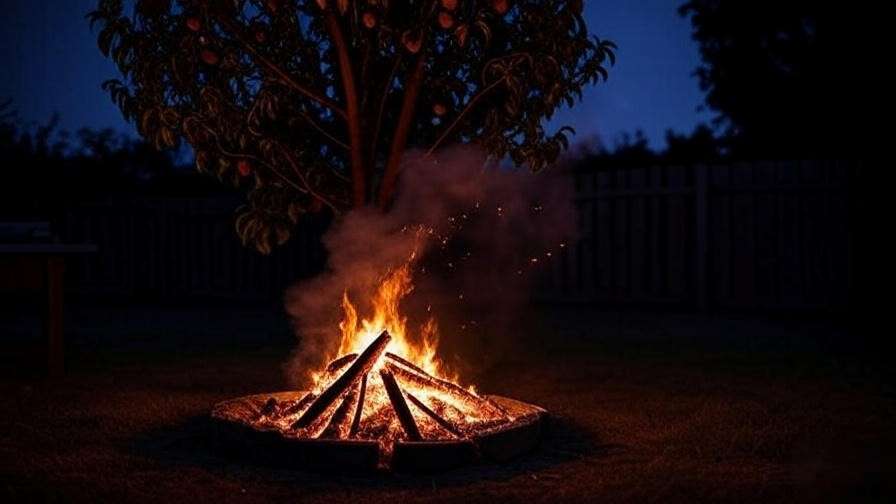
FAQs About Bonfires and Peach Trees ❓
Q: How far should a bonfire be from a peach tree?
A: Keep the bonfire at least 15–20 feet from the tree’s canopy, adjusting for wind and fire size.
Q: Can smoke from a bonfire kill a peach tree?
A: While unlikely to kill a healthy tree outright, prolonged smoke exposure can weaken it, increasing susceptibility to pests and diseases.
Q: What’s the best time of year for a bonfire near my peach tree?
A: Late fall or winter, when the tree is dormant, is safest to minimize stress and growth disruption.
Q: How do I know if my peach tree is damaged by a bonfire?
A: Look for wilting leaves, scorched bark, or reduced growth. Consult an arborist if you notice severe symptoms.
Expert Tips for Balancing Patio Enjoyment and Tree Health 🌱
To wrap up, here are expert tips to ensure your patio bonfires and peach tree coexist harmoniously:
- Use Eco-Friendly Fire Starters: Opt for natural starters, like wood wool, to avoid chemical residues.
- Monitor Tree Health Year-Round: Regular care, like proper pruning and fertilization, makes your peach tree more resilient to occasional bonfire stress.
- Consult Local Experts: For region-specific advice, reach out to your local cooperative extension service, which offers free resources on tree care.
Dr. Emily Carter, a horticulturist with the University of California Cooperative Extension, advises, “Peach trees are hardy, but consistent care and precaution during events like bonfires can extend their lifespan and productivity.”
Conclusion 🌞
A patio bonfire and a thriving peach tree don’t have to be at odds. By understanding the risks, planning your setup carefully, protecting your tree during the fire, and providing post-bonfire care, you can enjoy cozy evenings without compromising your tree’s health. Whether you choose a smokeless fire pit, an electric heater, or decorative lighting, there are plenty of ways to create a warm, inviting patio while keeping your peach tree safe. Share your own bonfire tips in the comments below, or explore our other articles on fruit tree care for more ways to nurture your garden. Here’s to creating a beautiful, tree-friendly outdoor space! 🌳✨

